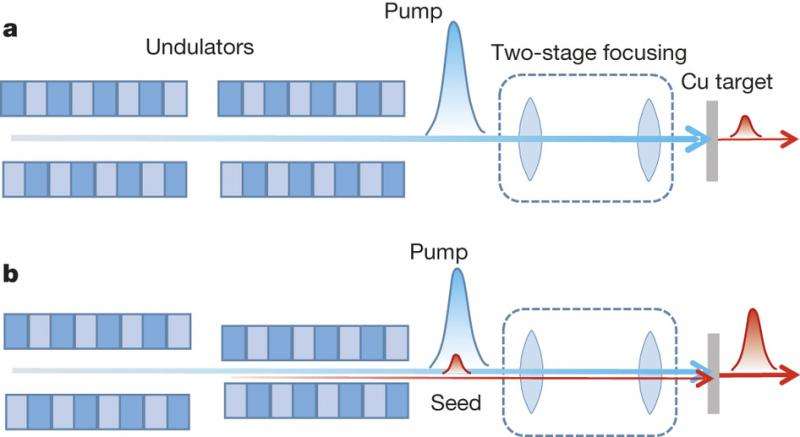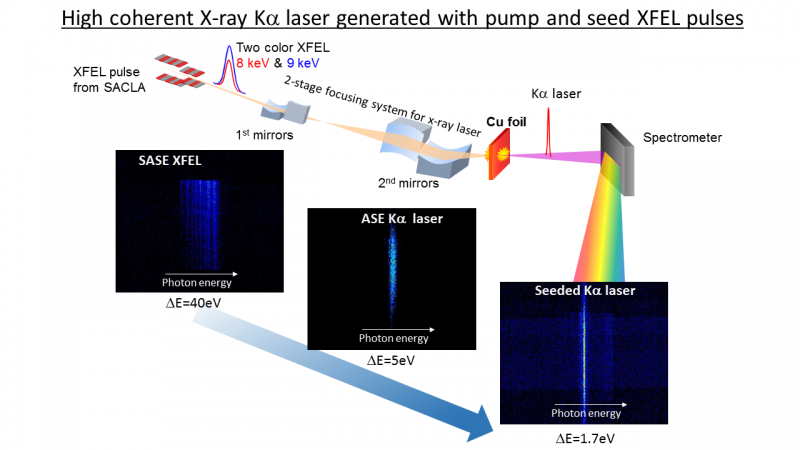August 27, 2015 report
Researchers develop atomic laser operating at the shortest wavelength yet

(Phys.org)—A team of researchers with affiliations to several facilities in Japan has succeeded in developing an atomic laser that operates at the shortest wavelength yet. In their paper published in the journal Nature, the group describes how they built their laser and how it performed. Linda Young, with Argonne National Laboratory in the U.S. offers a News & Views piece on the work done by the team in the same journal edition, highlighting the development effort and the means by which the result was tested.
As Young notes, X-rays are able to provide us pictures of the inside of things such as body parts, because they are able to penetrate matter and then to offer a contrast, via magnetic, chemical or elemental properties between different body parts inside. She also notes that back in 1960, Theodore Maiman demonstrated for the first time that a laser, if operated at an optical wavelength could also operate as a an X-ray, but at a much smaller scale—this opened the door to atomic X-ray machines that could offer us images of such things as molecules. But, as the researchers with this new effort note, there is still a desire to produce lasers with ever shorter wavelengths that generate coherent X-rays—because as the wavelength is shortened, the better the resolution of the device.
Another bonus is that it allows for shorter pulses of light, which allows for better resolution when engaged in probe measurements. Moving to a shorter wavelength, Young notes, has been held back due to a problem inherent with the technology, namely that the power required to operate them skyrockets as the wavelength grows shorter, requiring, for example, a 1015-fold increase in pump power density when going from a laser operating at 7,000Å to one running at 1.54Å. To overcome this limitation, the researchers used free-electron type lasers that are based on self-amplified spontaneous emissions. When using a copper target, they found that they could produce a hard-X-ray shell atomic laser capable of operating at a wavelength of 1.5 ångströms.

While impressive, the technology is not yet ready for primetime, Young, notes, the laser did not achieve saturation and some tests, such as angular divergence were not performed. Still, she notes, the work done by the team and others suggests that researchers will very soon be able to make use of very-short wavelength based lasers, offering perhaps, unprecedented resolution and atomic measurement capabilities.
More information: Atomic inner-shell laser at 1.5-ångström wavelength pumped by an X-ray free-electron laser, Nature 524, 446–449 (27 August 2015) DOI: 10.1038/nature14894
Abstract
Since the invention of the first lasers in the visible-light region, research has aimed to produce short-wavelength lasers that generate coherent X-rays1, 2; the shorter the wavelength, the better the imaging resolution of the laser and the shorter the pulse duration, leading to better temporal resolution in probe measurements. Recently, free-electron lasers based on self-amplified spontaneous emission3, 4 have made it possible to generate a hard-X-ray laser (that is, the photon energy is of the order of ten kiloelectronvolts) in an ångström-wavelength regime5, 6, enabling advances in fields from ultrafast X-ray spectrosopy to X-ray quantum optics. An atomic laser based on neon atoms and pumped by a soft-X-ray (that is, a photon energy of less than one kiloelectronvolt) free-electron laser has been achieved at a wavelength of 14 nanometres7. Here, we use a copper target and report a hard-X-ray inner-shell atomic laser operating at a wavelength of 1.5 ångströms. X-ray free-electron laser pulses with an intensity of about 1019 watts per square centimetre7, 8 tuned to the copper K-absorption edge produced sufficient population inversion to generate strong amplified spontaneous emission on the copper Kα lines. Furthermore, we operated the X-ray free-electron laser source in a two-colour mode9, with one colour tuned for pumping and the other for the seed (starting) light for the laser.
Journal information: Nature
© 2015 Phys.org


















